|
Spinning Low-Twist Singles
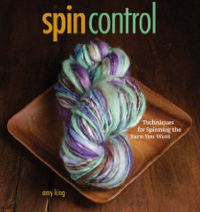 
excerpt from Spin Control: Techniques
for Spinning the Yarns You Want
by Amy King
I have always been in love with good singles—low-twist
singles, fulled singles, energized singles. They’re
fun to make and fun to use. They’re
essentially not much different
from plied yarns, except that you get to use them sooner.
They are weaker than plied yarns but used for the right project,
they’re wonderful. Singles
can also be challenging,
but armed with the right tools, you’ll
be able to make consistent
singles yarns.
Low-twist Singles
Low-twist singles are sometimes
available commercially, although they are often fulled to
make them stronger and ensure that the fibers in the yarn
hold together well.
These yarns can be a challenge
for many spinners. How much
twist is enough to hold
the yarn together without making an unmanageable overtwisted
yarn? It’s all about finding
the right amount of twist
per inch. For thin low-twist singles, aim for about 2 to
3 twists per inch; for thicker low-twist singles, you need
less than one twist per inch. For thick-and-thin singles,
there will be sections of higher and lower twist.
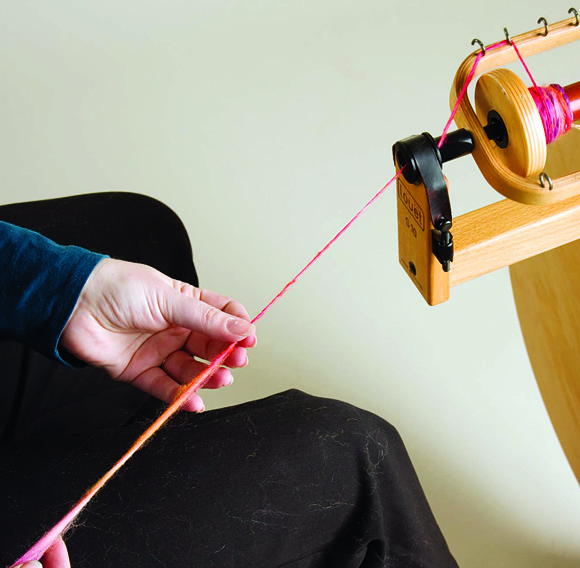
low-twist
single spun woolen-style
For all low-twist singles,
adjust your wheel for a faster
uptake and lower twist ratio
than you would use to make
energized singles or yarns for plying. Don’t hold onto the yarn for so long that a
lot of twist builds up; let it feed onto the wheel fairly
quickly. Choose airy fibers that you can draft easily; you
want to be able to choose whether to draft thin or thick.
A low-twist singles is one yarn for which it’s easy
to predraft too much. If you severely strip down the fiber
and feed it onto the wheel without drafting, you’ll
make a heavy, dense yarn.
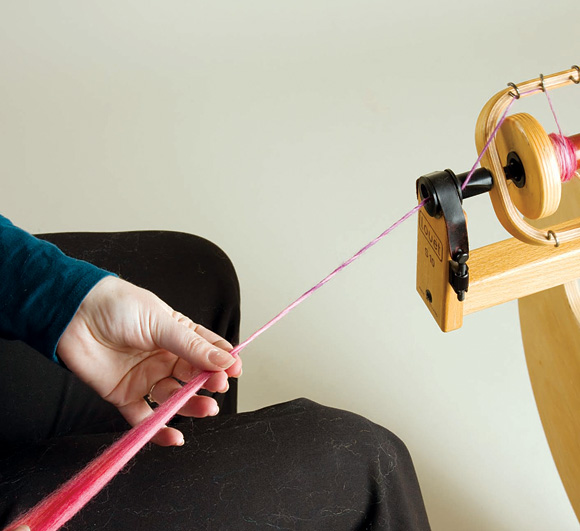
low-twist single spun
worsted-style
Also consider the staple
of your fibers. Shorter fibers
and thinner yarns need more
twist than long fibers and
fat yarns. This is no less
important in a low-twist
yarn than a tightly twisted one. Low twist doesn’t mean spinning
to the same number of twists per inch for every type of fiber.
It means that the yarn has low twist relative to that particular
fiber type and yarn thickness.
If you are just beginning to experiment with low-twist yarns,
practice with longer-staple fibers. It is easier to spin them
in a continuous thread, and it will build your confidence
and physical memory. When you move on to a more difficult
fiber, your hands and feet will have a better idea of how
to behave.
Some fibers are not suited for low-twist singles. Although
singles made with short-staple
fibers can be fulled to hold
them together, superwash wool yarns and cotton yarns cannot
be fulled. These yarns are more likely to fall apart and,
in general, shouldn’t
be used for low-twist singles.
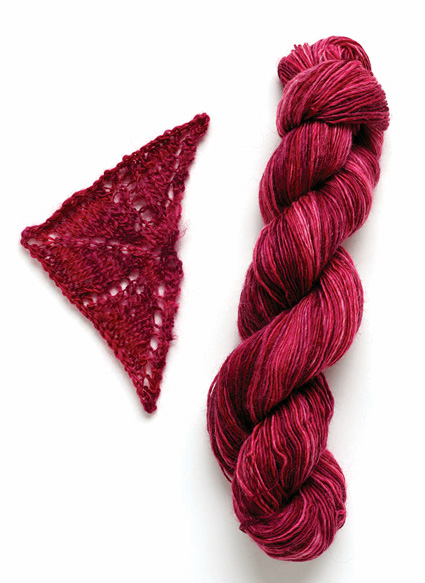 
Thin Low-twist Singles
This yarn is wonderful for
lace. It’s difficult to find from commercial sources,
so you have the opportunity to make something unique. The
basic process to make it is the same as for other low-twist
yarns—use strong draw-in to add less twist. It is
especially important to use airy, easily drafted fibers.
Thin low-twist singles yarn is interesting because it’s
challenging to find the right
balance of twist for such a thin yarn. But aside from the
spinning challenge in creating a good usable yarn, there’s
a benefit to the lace knitter: a well-made singles yarn won’t
split like so many plied lace yarns do.
This yarn can be fulled,
but this Romney laceweight
singles has enough twist
to keep it stable without
fulling. If the fibers are
long, as in this Romney, and the yarn is well spun, there
is no need to full it, though you can if you want assurance
it will hold. If you’re spinning
a shorter-staple fiber and
you want to be assured the yarn will hold, then by all means
full it.

 
[Did you know she Hula Hoops?]
JM: Why did you want to write this book?
AK: I love spinning. It is
my passion and I wanted
to share it. It's like
when you find a really
good ice cream brand, you
want all your friends to
try it. This
is what I want. I want
to share spinning with
everyone. I want them to
love it like I do and know
what I know.
JM: What did you want to spinners to learn?
AK: I think the main thing
I want people to take away
from the book is a “Yes, I
can” feeling. I want people to learn that they can
do it. They can make what
they want. With some knowledge
and practice any yarn is
possible.
JM: How is your approach to spinning different than
other spinning teachers?
AK: I don't know if it's
necessarily different. I approach teaching
with knowledge, information,
and lots of good fiber.
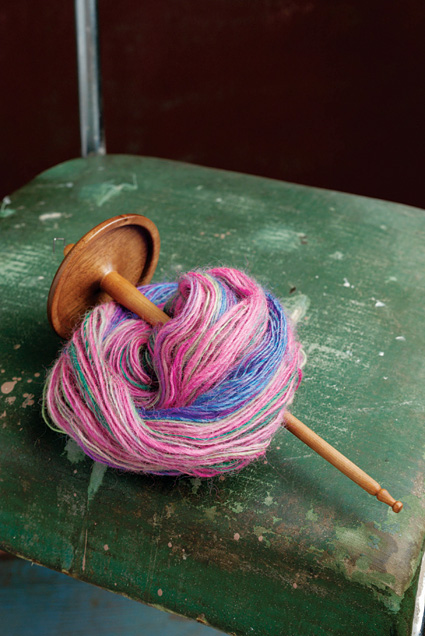 
JM: You used to be a potter, how did you move from pottery to fiber?
AK: Fiber was a hobby, pottery
was my occupation. Homeschooling
kids and being home more,
just didn't work out too
well with a business that
had me on the go all the time. When it turned out that people
really wanted the fiber I was creating...it just happened
organically.
JM: What’s next for you – what
do you want to learn?
AK: I want to learn it all.
I hope I never stop learning.
I'm a fair weaver but I want to be a much better weaver. I'm
also a fair hula hooper and
I want to be really graceful
(something I've never been).
JM: Will you start traveling and teaching?
What’s on
your schedule?
AK: I am traveling and teaching
a bit. It takes a bit of
a balance between the kids, shop, dyeing, and events. I will be in Michigan at The
Spinning Loft in September and at SOAR in October.
I'm already
working on dates for 2010 but nothing is set in stone at the
moment.
3 tips for spinners
1.Sample. Learn to sample.
It's so worth it. From these samples make index cards that
hold information about the yarn you spin so you can easily
duplicate it.
2. Try everything and listen
to those around you. You never know what you'll learn from
making a yarn that you don't desire. It may improve
the yarn you do want to make. I know that seems like
an abstract concept but sometimes it really works.
3. Most importantly, don't
give up. Keep working at it, find a teacher, read more, you
can do it. If you really want to do it, it just takes
practice and perseverance.
|









